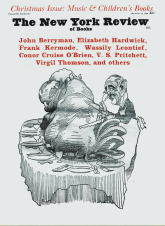To the Editors:
The newspapers and magazines have reported and reproduced the more dramatic disasters caused by the flash floods that submerged half of Florence on November 4th: Cimabue’s Crucifix, ruined beyond recall; Brunelleschi’s Pazzi Chapel coated to a level of some 20 feet with mud and oil; the pink and white marble of Giotto’s Campanile, Michelangelo’s Pitti Madonna, his Bacchus, his Brutus, Masaccio’s Trinity, Donatello’s Magadalen—all disfigured by the thick black fuel oil that is seeping into marble and wood; the loss and miraculous recovery of the five panels of Ghiberti’s Gates of Paradise.
These, and many more—carrying the names of Botticelli, Uccello, Simone Martini—are the public glories of Florence, sources of pleasure to the amateur as well as the scholar. To the readers of The New York Review of Books it is undoubtedly of additional interest to know what has happened to the less famous but equally irreplaceable riches of Florence—its books, manuscripts, and archives.
The Biblioteca Nazionale—equivalent to our Library of Congress—is reported to have sustained the most damage in the city. Its card catalogue was under water for days, the Union Catalogue, on which work had been going on for years, was completely destroyed. The elephant folios of the Magliabecchiana and Palatine collections, which were stored in the basement, along with unexplored documents pertaining to the sixteenth, seventeenth, and eighteenth centuries were also destroyed. In addition, the only complete files of all the Italian newspapers from 1870 on were destroyed. Miles of stacks were destroyed and the library may not be open to the public for years.
The State Archives in the Uffizi, which was the first building to be hit, had valuable holdings in the basement, for which there were no indexes, such as the libraries of suppressed convents and monasteries, some dating back to 1200. Forty rooms have been buried in mud. Here rescue work will be extremely perilous since the vault that supported the floor of one of the ground floor rooms has already collapsed. Given the speed with which Vasari built the Uffizi, it is feared that further damage, such as the collapse of more vaults, might lead to total destruction.
The list goes on: University Library, Department of Humanities, 250,000 volumes lost; Law Library, 80,000 volumes damaged; Gabinetto Vieusseux, specializing in nineteenth-century material in all languages, 200,000 volumes buried; Ospedale degli Innocenti, archives destroyed; Museo Bardini, ancient musical instruments, damaged; Conservatorio Cherubini, musical manuscripts, mostly unpublished, damaged. In the Synagogue on the Via Carducci, precious scrolls that had escaped destruction during the German occupation were soaked in mud.
As in every catastrophe, stories continue to emerge of devotion and dedication: of the personnel of the Uffizi appearing at dawn, unsummoned, to begin rescue work; of the Greek Orthodox monks of Grottaferrata arriving in Florence with talcum powder and blotting paper to begin salvaging manuscripts. The estimates of damage caused to art, architecture, libraries, and archives are still incomplete, but we know that prompt action is needed to prevent these serious losses from becoming a permanent disaster. Dr. Ugo Procacci, Soprintendente alle Gallerie, has written, “We are reclaiming the books from the mud, and if the work of recovery and of first emergency repair is not done within a few days, everything will be lost: the mud causes the paper to rot.”
CRIA (Committee to Rescue Italian Art), a nation-wide American committee, has been incorporated with a complete organization extending throughout the United States to lend aid to the Italians in their own efforts. Mrs. John F. Kennedy has assumed the Honorary Presidency of the organization. An Advisory Committee is headed by Professor Millard Meiss of the Institute of Advanced Study, Princeton, who gave distinguished service in recovery and restoration of Italian art damaged in World War II. An executive committee has among its members distinguished representatives of universities and museums throughout the country.
The principal aim of CRIA is to contribute financial support to the salvage and restoration of works of art which the Italian authorities will undertake, and to assist them directly with staff, materials, and equipment. Nineteen experts on the restoration of paintings, books, and manuscripts have already been sent on an Alitalia plane, accompained by a large freight load of materials and equipment for restoration requested from Florence by telephone.
It is hoped that all those who have benefited by the intellectual resources as well as the beauties of Florence will send their contributions to CRIA, Inc., 1 East 78th Street, New York, N.Y. 10021.
Bates Lowry, Chairman
Brown University
Sydney J. Freedberg, Vice-Chairman
Harvard University
This Issue
December 15, 1966



